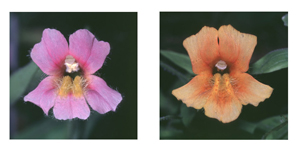|
Biology professor Toby Bradshaw is broadly interested in evolutionary biology. His research focuses on the evolutionary genetics of novel adaptations to environmental challenges. “Much of evolutionary theory was outlined by Charles Darwin 150 years ago,” Toby began. “But the genetic architecture of adaptive evolution was the biggest question that Darwin couldn’t address because he didn’t know about genetics. Now we do.” And with the advent of modern genetic and genomic tools, pinpointing the exact mutations that lead to a novel adaptation is a very attainable goal and an important one, as well. The trajectory leading to a new species is thought to begin with a novel adaptation, but what exactly it takes for a new species to originate is the over-arching mystery every evolutionary biologist is keen to unravel.
|
Toby’s research focuses on two species of wildflower native to western North America, Lewis’ monkeyflower and scarlet monkeyflower. These two species are each other’s closest relative and can easily be hybridized in the greenhouse, though hybrids in nature are rarely observed, even when the species are living side by side. This is because bumblebees pollinate Lewis’ monkeyflowers and hummingbirds pollinate scarlet monkeyflowers and the two species have a suite of divergent floral traits to attract their respective pollinators. For example, Lewis’ monkeyflower is pink and scarlet monkeyflower is, as the name implies, red. The family tree of monkeyflowers suggests the ancestor of Lewis’ and scarlet monkeyflowers was bumblebee pollinated; so, the novel adaptation between this pair is hummingbird pollination. Therefore, the question is: How many genes does it take to go from a bumblebee-pollinated flower to a hummingbird-pollinated flower, thus ensuring the formation and maintenance of a species boundary (via pollinator specificity)?
|
Currently Toby’s lab is narrowing in on genes responsible for flower color. Novel adaptations in scarlet monkeyflower include several genes controlling deposition of yellow and red pigments in different parts of the petals. The combination of genes changes the color dramatically, but changing one gene at a time also has significant effects. The goal is to find out how big a difference each gene makes to a pollinator. Toby plans to find this out by substituting genes in each monkeyflower with the other species’ genes. This is accomplished simply by crossing flowers with the desired traits and is practiced routinely in the agriculture and horticulture industries. One resulting plant may look entirely like a Lewis’ monkeyflower except instead of a pink flower there’s an orange flower.
To test whether each substitution makes any difference to a hummingbird or bumblebee, the novel plants are put outside in controlled plots with the normal plants and pollinator visitation to all plants is recorded. The first experiment of this nature yielded stunning results: By substituting a small region of Lewis’ monkeyflower genome with scarlet monkeyflower DNA, the pink flower of Lewis’ monkeyflower turned orange; consequently, visitation by hummingbirds spiked and visitation by bumblebees plummeted. New trials with different flower color substitutions are planned for this summer.
Evolution In The Evening
This spring Toby is hosting a public discussion-based lecture series on evolution. Even among those who accept it, evolution can be difficult to understand and can at first seem counterintuitive. So Toby will discuss some of the evidence for evolution and why scientists accept evolution as the explanation for the origin of all life on Earth. He plans to discuss a few of the major questions still open in evolution and what sort of evidence might help close those questions. He also intends to talk about the erroneous view that evolution is only useful as an explanation for things that happened in the past, and that it has no value for predicting the future. But mostly Toby plans to cover anything that people are curious to know more about, such as the fossil record, human evolution, the origin of species, or the rise of antibiotic-resistant bacteria.
“I’m sure it will be fun,” Toby says of the series, “I’d like to get a wide range of people with diverse backgrounds and views.” And he’s not averse to strong opinions on any side. A driving belief behind the series, he explained, is that the University is a state institution and serves all of the state’s population; it’s for more than just the current students. Because he’d like to see greater community involvement at the UW, he’s offering this series. The topic could not be more relevant: Evolution has always faced a hostile climate despite the remarkable amount of evidence that has come to support it. And with some presidential candidates publicly expressing their disbelief in evolution, it’s likely that it will for a while longer.
Evolution in the Evening will take place on Thursday evenings from 7:00 – 8:30pm in Hitchcock Hall on the Seattle campus from April 3rd to June 5th. To register to attend Evolution in the Evening, please call (206) 685.2185 or email kbrady@u.washington.edu. There is no cost to attend.
For more information about Toby’s research, visit his website: http://faculty.washington.edu/toby/.





